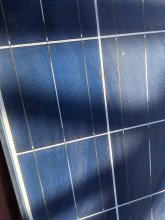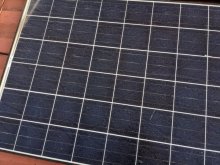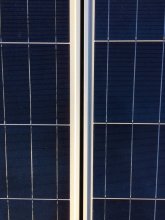dudeinthewoods
New Member
- Joined
- Apr 7, 2020
- Messages
- 111
So I've currently got 13 250w panels on top of a shipping container.
I noticed the last few days the power they put out is pretty terrible. I used to get 2kw~ or so and now I'm getting like 350w combined.
I've got some pics I'll attach. They look burned on all the wires around the cells. The bus up top etc too.
Now a little bit ago I had a relay fail and it wrecked my lifepo4 setup (really pissed). I reversed polarity and it burned out a charge controller (maybe internal fuse, haven't pulled it).
So I was thinking that may have wrecked the panels. Here's the part that I don't get. 3 SCC and all 3 sets of panels are burned. So I'm thinking they're partially intact. I'll test each panel individually to see how they're doing soon.
That sort of made sense even though the surge was all through one SCC but maybe somehow it happened, I don't know.
Then I realized that 2 panels I had just sitting next to the others are burned. They're not connected at all to anything. They're sitting on the container (it's actually 3 containers one set of panels per).
I'm just scratching my head now.
Also there dusty as hell. They cut hay a few days ago so now that I saw how bad they are I'm going to clean them and see if production goes up too.
Any thoughts?

I noticed the last few days the power they put out is pretty terrible. I used to get 2kw~ or so and now I'm getting like 350w combined.
I've got some pics I'll attach. They look burned on all the wires around the cells. The bus up top etc too.
Now a little bit ago I had a relay fail and it wrecked my lifepo4 setup (really pissed). I reversed polarity and it burned out a charge controller (maybe internal fuse, haven't pulled it).
So I was thinking that may have wrecked the panels. Here's the part that I don't get. 3 SCC and all 3 sets of panels are burned. So I'm thinking they're partially intact. I'll test each panel individually to see how they're doing soon.
That sort of made sense even though the surge was all through one SCC but maybe somehow it happened, I don't know.
Then I realized that 2 panels I had just sitting next to the others are burned. They're not connected at all to anything. They're sitting on the container (it's actually 3 containers one set of panels per).
I'm just scratching my head now.
Also there dusty as hell. They cut hay a few days ago so now that I saw how bad they are I'm going to clean them and see if production goes up too.
Any thoughts?








